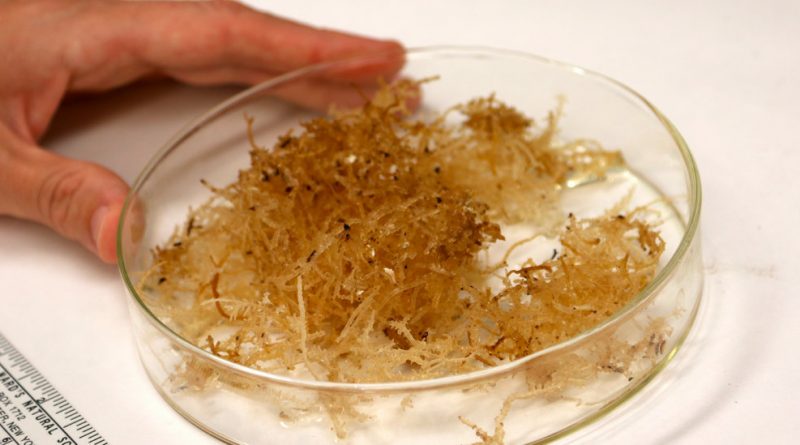New Red Algae Are Threatening Hawaii’s Coral Reefs, Scientists Say
[ad_1]
On a routine trip to monitor ocean wildlife near the northwestern Hawaiian Islands in 2016, researchers noticed small patches of red algae they had never seen before growing on the coral reefs.
When they returned last summer, the algae had spread exponentially. Mat-like layers now cover vast swaths of coral in the Pearl and Hermes Atoll, a remote, uninhabited portion of the protected Hawaiian Islands around 1,200 miles from Honolulu.
The prolific alga is a previously undiscovered species, according to a study published Tuesday from researchers at the University of Hawaii. Scientists say it poses a threat to coral and other marine life in the area.
“Something like this has never been seen in the northwestern Hawaiian Islands before,” said Alison Sherwood, lead researcher of the study. “This is extremely alarming to see an alga like this come in and take over so quickly and have these impacts.”
Scientists determined the alga, which they named Chondria tumulosa, didn’t match any known species, Dr. Sherwood said. Though it behaves like an invasive species, disrupting its new environment, it cannot be labeled one because it hasn’t been traced to an outside source. Scientists instead refer to it as a nuisance species.
The alga’s sudden appearance and rapid spread are cause for concern, Dr. Sherwood said.
When the alga grows on coral, it blocks sunlight, essentially smothering the coral and anything else living underneath it, Dr. Sherwood said. It takes up space where other algae or seaweed species that feed herbivores would naturally grow.
“It’s essentially changing the entire community composition there and that’s going to have ripple effects up through the food chain,” Dr. Sherwood said.
The Pearl and Hermes Atoll is found within the Papahanaumokuakea Marine National Monument, a World Heritage site and protected marine sanctuary that encompasses the northwestern Hawaiian Islands.
Randall Kosaki, the deputy superintendent of the monument for the National Oceanic and Atmospheric Administration, was chief scientist on the cruise that discovered the algal outbreak. It took the team four days by boat to reach the Pearl and Hermes Atoll.
“This is an organism that has the potential to completely overrun an entire island or an entire atoll,” Dr. Kosaki said. “Whether it will do it or not, time will tell.”
In marine environments, invasive species spread so easily that once a species gets into an ecosystem, there’s virtually nothing to be done, he said. “Prevention is the only tool in our toolbox.”
To ensure that they did not spread the algae to other islands when they returned to Honolulu, the researchers doused their dive gear in bleach.
“God forbid that we bring this back to Oahu or Waikiki, where the consequences would not just be an ecological disaster but an economic disaster, because Hawaii’s economy is so heavily based on tourism,” Dr. Kosaki said.
Researchers observed that local grazers, like surgeon fish, that usually spend days munching on algae weren’t seen grazing on the new algae, Dr. Kosaki said. This may indicate it isn’t a native alga, because most native algae have natural predators, he added.
“At this point we don’t know if it’s a native species that was just overlooked until it went berserk at this one atoll or an introduction whose natural range may be thousands of miles away,” he said.
Though there was no record of other invasive seaweeds in the area, there have been bloom-forming algae species seasonally in the past, Dr. Sherwood said. But this is the first time scientists haven’t been able to track an alga’s origins.
Scientists observed that large pieces of the alga, around three feet long, could be detached from the coral. These “tumbleweed-like pieces” are moved around by ocean currents and then attach and form new mats elsewhere, Dr. Sherwood said. The samples they studied in the lab formed spores, which may also spread the algae further.
Peter Mumby, a professor at the University of Queensland and chief scientist at the Great Barrier Reef Foundation, said unusual water chemistry or an absence of natural consumers of the alga could be possible causes for the bloom. He was not involved in the study.
“In terms of what it means for the reefs there, it might well reduce coral recovery by preventing new corals from getting a decent foothold on the reef,” Dr. Mumby said. “It really depends on how permanent this bloom will be.”
The Papahanaumokuakea Marine National Monument was created in 2006 and expanded in 2016 under President Barack Obama to cover more than 580,000 square miles. It is home to an estimated 7,000 marine and terrestrial species, a quarter of which are found nowhere else on earth.
“This is just our initial window into what’s happening,” Dr. Sherwood said. “The observations that we made last summer about it overgrowing and killing the coral on which it’s growing doesn’t bode well for coral.”
